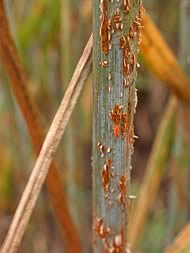 |
|||||||||
|
|||||||||||||||||||
|
|
Wheat
Stem Rust Spreads from East Africa 12/04/07 A new and virulent fungus that attacks a wide range of wheat varieties has spread from East Africa to Yemen on the Arabian Peninsula, FAO reported today.
The wheat stem rust (Puccinia graminis), also known as wheat black rust, is capable of causing severe losses and can destroy entire wheat fields. It is estimated that as much as 80 percent of all wheat varieties planted in Asia and Africa are susceptible to this new strain. The spores of wheat rust are mostly carried by wind over long distances and across continents. “Global wheat yields could be at risk if the stem rust spreads to major wheat producing countries,” said FAO Director-General Dr Jacques Diouf. “The fungus can spread rapidly and has the potential to cause global crop epidemics and wheat harvest losses of several billion dollars. This could lead to increased wheat prices and local or regional food shortages. Developing countries that are relying on wheat and do not have access to resistant varieties will be particularly hit,” Dr Diouf said. FAO has joined the International Center for Agricultural Research in the Dry Areas (ICARDA) and the International Maize and Wheat Improvement Center (CIMMYT), which are leading the Global Rust Initiative (GRI), an international consortium to fight the spread of rust fungus diseases around the world. Canada, the United States and India are the main donors to the GRI. Ug99 The new pathogen first emerged in Uganda in 1999 and is therefore called Ug99. It subsequently spread to Kenya and Ethiopia. A recent FAO mission in the field has confirmed for the first time that Ug99 has affected wheat fields in Yemen. It appears that the Ug99 strain found in Yemen is already more virulent than the one found in East Africa. Samples of the pathogen were sent to the United States and Canada for further analysis. There is a high risk that the disease could also spread to Sudan. Past epidemics Wind-borne transboundary pests and diseases can cause serious damage to crop production. In the late 1980s, a virulent strain of yellow rust, a wheat disease similar to stem rust, emerged in East Africa and crossed the Red Sea into Yemen. It then moved into the Near East and Central Asia, reaching wheat fields of South Asia within four years. Major yellow rust epidemics were recorded with wheat losses of more than one billion US dollars. Based on monitoring of Desert Locust pathways, FAO does not exclude that wind currents could carry Ug99 stem rust spores from Yemen northwards along the Red Sea to Egypt or through the Saudi Arabian Peninsula towards countries in the Near East. On alert FAO urges affected countries and countries at risk to increase their disease surveillance. Yemen in particular should be on the alert, step up field monitoring and training and prepare for direct control interventions in disease hot spots. Most important, control measures in affected countries should include the introduction of more resistant wheat varieties and restricting planting dates to break the disease cycle. FAO, ICARDA and CIMMYT will support countries in developing resistant varieties, producing their clean quality seeds, upgrading national plant protection and plant breeding services and developing contingency plans.
|
||||||||||||||||||

|
|
||||||||||||||||||
| home | agri-services | pedigree
pen | news | dairy | beef | machinery quota | property | organisations | site map |
|||||||||||||||||||

